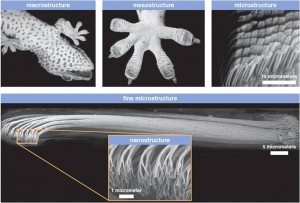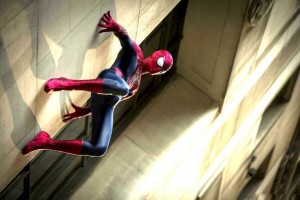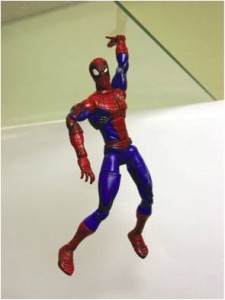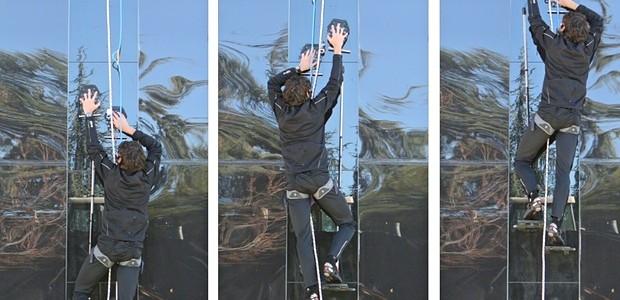So the pop culture-science side of the internet has been buzzing about a study recently published in Proceedings of the National Academy of Sciences and its implications for Spider-Man. In short, the paper (which can be read here) says that for creatures that have adhesive pads used for climbing, there is an upper limit.
The adhesive pads themselves are cool – they independently evolved a a handful times in different species, ranging from geckos to spiders and allow them to crawl leisurely up a wall, or skitter across the ceiling when you’re trying to get to sleep, fueling your nightmares for the night. But what makes the pads themselves work? Smaller and smaller branches called setae. These small bristles work via attraction at the molecular level.
 Think of it this way – the setae are small and hairlike, and each splits and splits into smaller and smaller bristles which then split some more until they’re nano (0.000000001 meters, or a billionth of a meter) sized with a flat tip. Now called spatulae, the bristles are so small they can “stick” to what the lizard is crawling on due to van der Waals interactions. Individually, van der Waals forces are pretty weak – they arise from the interactions between the positive and negative parts of molecules attracting and repelling one another. But the thing is, the foot of a gecko has millions of setae on its toes. Each “spatula” holds a teeny, tiny bit, millions of them hold a lot.
Think of it this way – the setae are small and hairlike, and each splits and splits into smaller and smaller bristles which then split some more until they’re nano (0.000000001 meters, or a billionth of a meter) sized with a flat tip. Now called spatulae, the bristles are so small they can “stick” to what the lizard is crawling on due to van der Waals interactions. Individually, van der Waals forces are pretty weak – they arise from the interactions between the positive and negative parts of molecules attracting and repelling one another. But the thing is, the foot of a gecko has millions of setae on its toes. Each “spatula” holds a teeny, tiny bit, millions of them hold a lot.
Oh, and to go into the creepy, yes, spiders work pretty much the same way with setules play the same role, allowing them to crawl up walls, across ceilings, lower themselves on a webline and crawl into our mouths as we sleep. Okay, that last part was a lie.
They crawl in our ears.
So anyway, if these teeny, tiny things can hold a lot of weight, why can’t they hold Spider-Man? Well, for one, he wears gloves. But what the paper in PNAS was reporting on had to do with the old problem familiar to mad scientists and giant robot designers the world over – surface area vs. volume. They don’t increase at the same rate. In short, the more you weigh, the more surface area you’re going to have to give over to setae in order to stick to the wall. Which, unfortunately, makes a lot of sense right out of the gate.
Let’s say you’re an ant – small and with a very low mass, you’re going to need to give up 0.09% of your surface area to your adhesive pads to go climbing. As you get bigger, you need more surface area to haul your little butt up the wall – a spider is up to 0.92%, and our friend the gecko needs about 4.3% of its surface area to be adhesive pads in order to do the vertical dash.
By the time you get to something as big as a human, it’s just downright ridiculous – 40% of your surface area, or 80% if you’re only using one side of your body needs to be adhesive.
“If a human, for example, wanted to climb up a wall the way a gecko does, we’d need impractically large sticky feet – and shoes in European size 145 or US size 114,”says Walter Federle, the study’s senior author from Cambridge’s Department of Zoology in a press statement.
Although there may be hope for people whose name rhymes with Shmeter Shmarker and have a dead uncle named Ben – stickier sticky pads.
“We noticed that within some groups of closely related species pad size was not increasing fast enough to match body size yet these animals could still stick to walls,” says Christofer Clemente, a co-author from the University of the Sunshine Coast.
“We found that tree frogs have switched to this second option of making pads stickier rather than bigger. It’s remarkable that we see two different evolutionary solutions to the problem of getting big and sticking to walls,” says Clemente. “Across all species the problem is solved by evolving relatively bigger pads, but this does not seem possible within closely related species, probably since the required morphological changes would be too large. Instead within these closely related groups, the pads get stickier in larger animals, but the underlying mechanisms are still unclear. This is a great example of evolutionary constraint and innovation.”
The authors point out this last bit as hope that artificial sticky pads – alright, let’s just call them bio-inspired adhesives at this point – could possibly be manufactured for large-scale applications. Currently, there are artificial bio-inspired adhesives out there. For example, a joint project between the Institute for Microelectronics Technology in Russia and the Manchester Centre for Mesoscience and Nanotechnology saw the creation of “Gecko tape,” which uses the same approach as geckos do to hold small things; while in 2014, a joint Stanford/Darpa project showed off gecko-inspired climbing pads for hands which allowed a graduate student to climb a glass wall. But even though the hand-pads look promising, ergonomically, crawling up a wall like Spider-Man is still amazingly difficult – you’d be constantly pulling with your arms and pushing with your legs.
Being Spider-Man would be exhausting.










